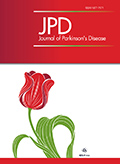Authors: Tanaka, Yasuhiro | Tsuboi, Takashi | Watanabe, Hirohisa | Kajita, Yasukazu | Nakatsubo, Daisuke | Fujimoto, Yasushi | Ohdake, Reiko | Ito, Mizuki | Atsuta, Naoki | Yamamoto, Masahiko | Wakabayashi, Toshihiko | Katsuno, Masahisa | Sobue, Gen
Article Type:
Research Article
Abstract:
Background: Voice and speech disorders are one of the most important issues after subthalamic nucleus deep brain stimulation (STN-DBS) in Parkinson’s disease (PD) patients. However, articulation features in this patient population remain unclear. Objective: We studied the articulation features of PD patients with STN-DBS. Methods: Participants were 56 PD patients treated with STN-DBS (STN-DBS group) and 41 patients treated only with medical therapy (medical-therapy-alone group). Articulation function was evaluated with acoustic and auditory-perceptual analyses. The vowel space area (VSA) was calculated using the formant frequency data of three vowels (/a/, /i/, and /u/) from sustained
…phonation task. The VSA reportedly reflects the distance of mouth/jaw and tongue movements during speech and phonation. Correlations between acoustic and auditory-perceptual measurements were also assessed. Results: The VSA did not significantly differ between the medical-therapy-alone group and the STN-DBS group in the off-stimulation condition. In the STN-DBS group, the VSA was larger in the on-stimulation condition than in the off-stimulation condition. However, individual analysis showed the VSA changes after stopping stimulation were heterogeneous. In total, 89.8% of the STN-DBS group showed a large VSA size in the on- than in the off-stimulation condition. In contrast, the VSA of the remaining patients in that group was smaller in the on- than the off-stimulation condition. Conclusions: STN-DBS may resolve hypokinesia of the articulation structures, including the mouth/jaw and tongue, and improve maximal vowel articulation. However, in the on-stimulation condition, the VSA was not significantly correlated with speech intelligibility. This may be because STN-DBS potentially affects other speech processes such as voice and/or respiratory process.
Show more
Keywords: Parkinson’s disease, deep brain stimulation, speech, dysarthria, speech disorder, acoustic analysis, articulation, speech intelligibility, formant analysis
DOI: 10.3233/JPD-160838
Citation: Journal of Parkinson's Disease,
vol. 6, no. 4, pp. 811-819, 2016
Price: EUR 27.50






